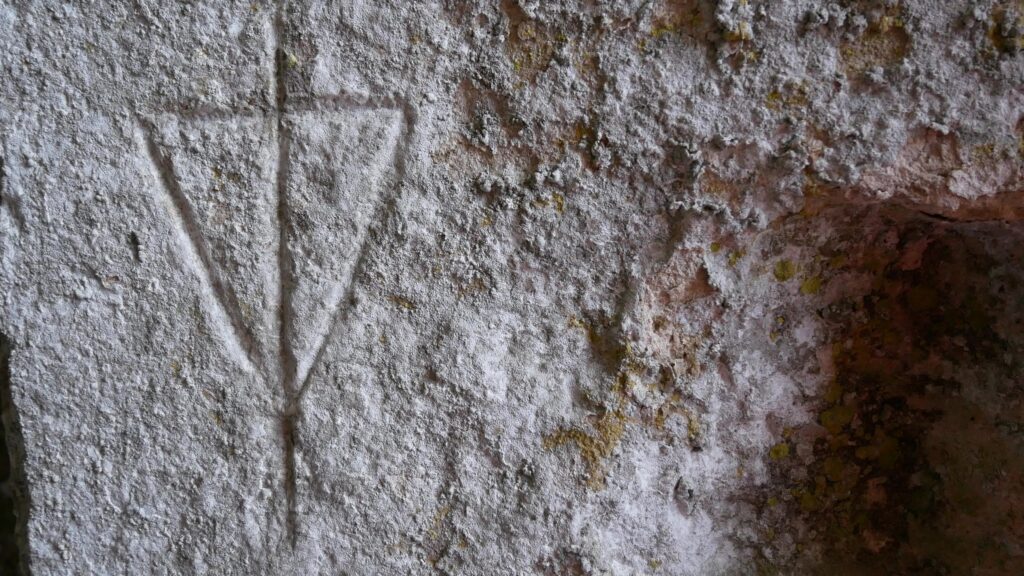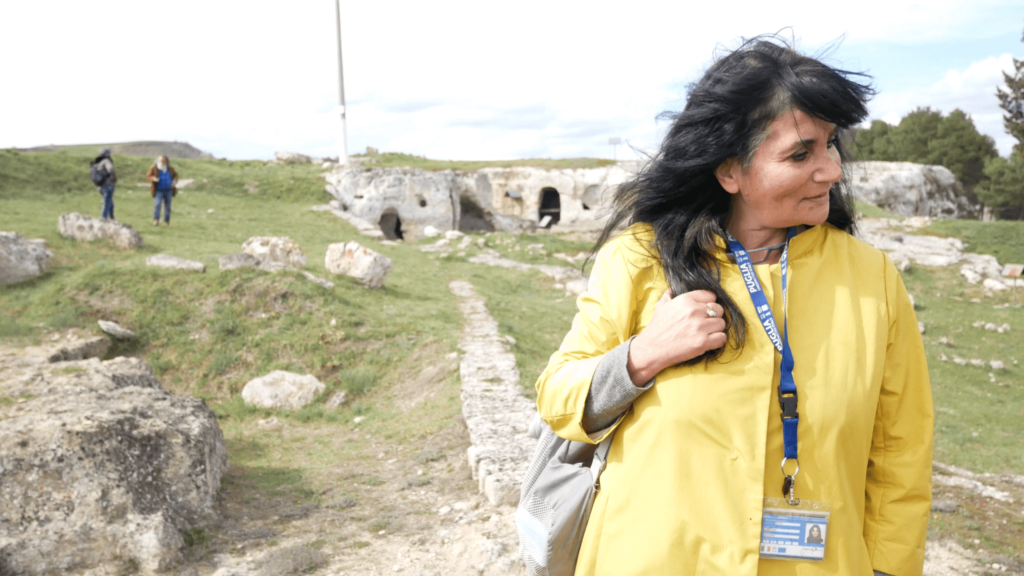Friday 3rd March 2023
We follow Donato’s white van across the scrublands, weaving a path between Altamura and the nearby town of Gravina. Arriving at our destination, we park our cars at the edge of a massive crevice. Peering below the grassy edge, it’s difficult to see what lies beneath.
Three women greet us: an archaeologist named Doriana Galella an archaeologist, an historian and witch called Antonia Laddaga, and her daughter Carmela Zuccaro who acts as our translator, but in fact has her own deep knowledge that she will come to share with us.
We walk down paths carved into the cliff face and reach a network of caves that were inhabited over thousands of years. The area is called the “Seven Chambers”, in part because seven was significant in Christian numerology and also because of the seven rooms that comprise the cave dwellings.


We are curious to know above all the relations between the former inhabitants and the stone that formed the architecture of their lives. The stone was seen as a “tabula rasa”, a blank slate, and that the water is the carrier of life, so as the water passes through the stone, it gives life to the stone. You could say that the water is like the “soul” of the stone body. Stones are also a way of recording time, the water passes through over centuries. The stone did not have a soul, but a soul can be brought in through the medium of water. The women show us a symbol, an upside-down triangle that means “water is there” but to which a crucifix was later added when the Seven Chambers were christianised.
We learn more about how the people related to the stone: in the past the caves were everything, the locals relied on them for protection, housing, and to venerate their gods. Over time, this relationship evolved. In the Middle Ages, people ceased living within the caves, instead using them to house their animals. Then, as they began constructing the towns, they excavated more, pulling stone from the caves but living above and beside them. The modern era brought novel materials like cement, which severed the bond between humans and stone. Stone came to be viewed as old-fashioned, inefficient, delicate, and time-consuming compared to cement, which required less care and enabled faster construction.
We recall the diggers we had seen yesterday, churning through the landscape beside the ancient carvings to produce the stuff.
Cement production alone accounts for a staggering share of the greenhouse gases in our atmosphere, around 8% and is radically altering our lived environment in ways we did not intend. Carmela explains that the acid rain that has arrived with industrialisation now carves its way into the stone a lot quicker than the rains that fell before, accelerating the rate at which it erodes. This phenomenon corresponds to the collective sense that time itself is accelerating. In the changing relationship between acidised water and ancient stone there is a material manifestation of the feeling that human society is spiralling out of control.

We leave the caves and walk further along the cliff tops. Adrienne asks Antonia why she is drawn to this space is interested in the space. She explains that she was born here, that she always played along this area as a child and she still lives nearby. Then her eyes glimmer and says, “I have a certain sensibility”. Carmela explains that people think of her as a witch. She has feelings about things before they happen. Adrienne asks if she also considers that she has a connection to the supernatural. She says yes, but that she doesn’t know where it comes from. Normally it is the seventh child in a family who might have such powers.
They take us to a carving on a cliffside overlooking the town. The carving bears the shape of a square with a circle in one corner. It was said that in this place, you are positioned to talk to the divine. We ask why the circle is not centered. The group speculates that this was so you do not imagine yourself as centered in the cosmic order. We each take turns to stand in the symbol, and the wind picks up, almost suspending us in the air.
During our time together, Doriana, Carmela and Antonia weave profound connections between the stone, water and human life in the town of Gravina, as we are leaving Carmela expands the fabric to encapsulate death as well. She explains that the canyon that surrounds the town, with its little meandering river, carve the shape of a skull in profile. This striking image confirms our felt sense of the region as one where death saturates life, and life saturates death, each giving the other meaning and form, like water in stone.